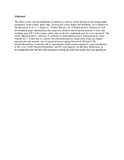Effect of African nightshade species (Solanaceae) on developmental time and life table parameters of Tetranychus evansi (Acari: Tetranychidae).
| dc.contributor.author | Murungi, LK | |
| dc.contributor.author | Nyende, A | |
| dc.contributor.author | Wesonga, J | |
| dc.contributor.author | Masinde, P | |
| dc.contributor.author | Knapp, M | |
| dc.date.accessioned | 2013-06-24T12:34:01Z | |
| dc.date.available | 2013-06-24T12:34:01Z | |
| dc.date.issued | 2010-09 | |
| dc.identifier.citation | Exp Appl Acarol. 2010 Sep;52(1):19-27 | en |
| dc.identifier.uri | http://hinari-gw.who.int/whalecomwww.ncbi.nlm.nih.gov/whalecom0/pubmed/20229322 | |
| dc.identifier.uri | http://erepository.uonbi.ac.ke:8080/xmlui/handle/123456789/39009 | |
| dc.description.abstract | The effect of five African nightshade (Solanum sp.) species on the biological and demographic parameters of the tomato spider mite, Tetranychus evansi Baker and Pritchard, was examined in the laboratory at 25 +/- 1 degrees C, 70-80% RH and 12L:12D photoperiod. Duration of each development stage, reproduction rate, longevity, intrinsic rate of natural increase (r (m)), and doubling time (DT) of the tomato spider mite on the five nightshade species were calculated. The results indicated that S. villosum, S. scabrum, S. tarderemotum and S. americanum are more suitable for T. evansi due to a shorter developmental period, longer adult longevity, higher reproduction and intrinsic rate of natural increase ranging between 0.180 and 0.196 females/female/day compared with S. sarrachoides which cannot support T. evansi populations as the r (m) (-0.063 females/female/day) and DT were negative on this host. Differences in developmental time and life table parameters among the other host plants were not significant. | en |
| dc.language.iso | en | en |
| dc.publisher | University of Nairobi. | en |
| dc.title | Effect of African nightshade species (Solanaceae) on developmental time and life table parameters of Tetranychus evansi (Acari: Tetranychidae). | en |
| dc.type | Article | en |
| local.publisher | Department of Surgery | en |
Files in this item
This item appears in the following Collection(s)
-
Faculty of Health Sciences (FHS) [10378]

